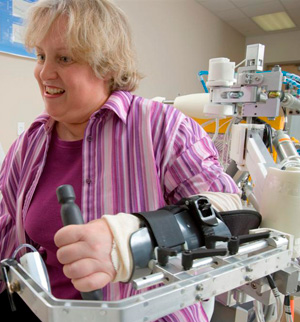Newsroom > News Release
Grant to Fund Stroke Robotic-Recovery Study
 |
| Control software developed for BONES, the robotic exoskeleton pictured, will be refined for use in a portable training device. |
|
More than half of all stroke patients suffer chronic motor impairment, with a large percentage experiencing difficulty in using their hand and arm. Calit2 affiliate David Reinkensmeyer, mechanical and aerospace engineering professor, will use a five-year, $1.5 million grant from the National Institutes of Health to determine the efficacy of robot assistance in restoring these fine motor skills.
Reinkensmeyer is collaborating with neurology professor Steve Cramer, electrical engineering professor Mark Bachman and former UCI doctoral student Eric Wolbrecht, who is now an assistant professor at University of Idaho. He says researchers know that exercise after stroke helps restore brain pathways, a concept known as use-dependent brain plasticity. What they don’t know is whether the exercise is more beneficial if it is aided by robots that guide the patients’ hands and help them complete specific tasks.
Current therapies were designed to be administered by physical or occupational therapists, limiting their affordability and availability. So, Reinkensmeyer says, there’s been a concentrated effort to develop technology that can automate these processes.
But does automation really make a difference? “People prefer exercising with a robot that helps them complete computer games, so there’s a motivational benefit to robotics. But it’s not clear yet whether having a robot assist a person is more effective than just having them exercise without it.”
Researchers will work with local hospitals, starting with UC Irvine Medical Center, to begin studying patients in the first days after stroke.
The pool of potential candidates is huge – there are four million people in Orange County and more than 40,000 have experienced a stroke.
Reinkensmeyer’s research effort is two-pronged. The team will build a wearable sensor that will measure patients’ hand movements in the days and weeks after stroke but before therapy begins.
They will also fabricate a compact, portable device to assist the patients at home as they exercise the affected hand. The “smart” apparatus will build a computer model in real-time of how much support each patient needs to complete the required tasks.
Reinkensmeyer envisions the sensor as a wristwatch-type device that can be strapped onto the affected wrist to measure immediately how much movement occurs. In the past, he says, patients have entered studies several months after stroke, preventing researchers from knowing how much movement the limb has already undergone.
After the patients have completed formal physical therapy, they will be randomly divided into two groups. In one group, the hand robot will assist in the limb exercises; the second group will use the robot, but it will be programmed so it is gives a higher level of assistance. The device, which will be small enough for home use, will provide engaging games that encourage stroke sufferers to practice moving their fingers in different configurations and in different gripping techniques.
Outcomes will be measured by therapists using standard assessment measurements; quantitative measurements from the robot will also be used.
Because the severity of stroke is an important factor in recovery, all patients will undergo pre-study brain scans. These scans will determine the degree of damage to the neurons and insulating material, the “telephone lines” that carry instructions from the brain to the muscles. The researchers hope to determine the extent to which brain imaging, sensor data and robot-assisted exercise can predict how much limb dexterity patients can expect to regain.
They hope the study can answer three questions, Reinkensmeyer says. Does the increased sensory input generated by the robot actually improve the outcome? Conversely, can too much robotic assistance actually decrease the patient’s effort level and ultimately his recovery? And finally, does the specific combination of intact brain matter, post-stroke history of hand movement and robotic exercise predict which patients will ultimately experience the most favorable outcomes?
Reinkensmeyer hopes the answers will provide insight into optimizing robot-control algorithms for automated movement training. “I think we’ll find out which particular set of robot parameters helps the person recover faster and better.”
-- Anna Lynn Spitzer

